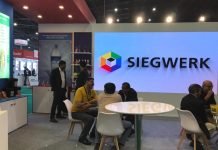The 4th annual InnoPack pharma conference held in Mumbai on 18 and 19 June 2015 saw stellar presentations from leading figures associated with the pharmaceutical packaging industry providing thoughtful insights on regulations, future trends, safety, and more. Professionals from packaging divisions of leading pharma companies, major label printers and converters, labelstock manufacturers, printing ink manufacturers, represented the complete spectrum of the pharma packaging sector. The event was organized by UBM and was well attended with the first day seeing a packed house.

The two-day event had many highlights with topics ranging from regulations for ink manufacturers, sustainable packaging, migration issue for labelstock and the latest trends in pharma labels. Stefan Hap, regional technical director of Siegwerk, spoke of the basic regulations and requirements for primary pharma packaging from a printing ink manufacturer’s perspective. He emphasized the importance of carefully selecting raw material and ink formulations. Hap also enlightened the audience on the future trends in flexible pharma packaging. He said that in the future the industry would be facing stricter regulations. Moreover, the trend is towards using high-speed blister machines with a speed of 600 blisters a minute, fast and safe in-line coding for pharma packaging, on demand printing and digital printing of blisters.
Aanand Khare discussed the importance of sustainable packaging. Head of innovation at ACG Pharmapack, Khare defines sustainability as understanding interconnections between the economy, society and environment. According to him sustainable packaging should be cyclic, safe, efficient and effective; neither over- nor under-packed; and have minimum material with minimum environmental impact. He feels sustainable packaging would help brand owners with brand recognition, product differentiation, address regulatory concerns, and would have a positive impact on end consumers.
Providing a point of view of labelstock manufacturers on the issue of migration, Ajay Mehta of SMI Coated Products said there were multiple options to tackle the problem. He suggested the use of low migration adhesive labelstock material with water-based inks; low migration adhesive labelstock material with filmic face material; low migration adhesive labelstock material with paper having foil laminate on the back side; and changing the LDPE container to a better barrier material like glass.
Karan Kapur of Mumbai-based JK Labels, a supplier of quality speciality labels, talked about the evolution of pharma labels over the years, highlighting the challenges that label suppliers are facing. Migration, silicon contamination of vials and pre-filled injections, low mandrel performance, moisture collection on vials and injections after filling, detecting clear labels on high speed lines and counterfeiting are some of the issues, Kapur said. He spoke about the latest trends in speciality labels such as freeze proof labels, hanger labels, blood bag labels, track and trace labels, filmic liners. For anti-counterfeiting solutions he spoke of substrate-based void labels, inbuilt embossed effects, fibre tear and others. Value-based solutions include security inks, nano lines and holograms according to Kapur.











